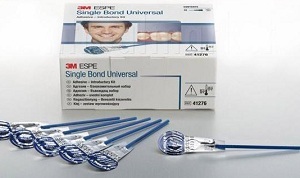 Adper Single Bond Universal is a self-etching dental adhesive. With its help, bonding of all kinds of surfaces is carried out without additional primer processing.
Adper Single Bond Universal is a self-etching dental adhesive. With its help, bonding of all kinds of surfaces is carried out without additional primer processing.
When fixing orthopedic structures, it can be combined with composite cements and materials to restore the stump of the tooth.
Single Bond 2 is the representative of the 5th generation of adhesive systems. For its application, the tooth surface is pretreated with an air conditioner, in which case orthophosphoric acid acts. This substance contains in its composition both adhesive components that form a hybrid layer, and special substances that promote the bond of this layer with the composite. To increase its strength, special nanofillers are added to the formulation.
Contents
- Composition Features
- Material Properties
- Scope
- How to use?
- Special instructions
- Cost and analogues
Features of the composition
Substances included in the Single Bond Versatile:
- monomer MDP;
- resins based on dimethacrylate;
- HEMA;
- special Vitrebond copolymer;
- filler;
- ethanol;
- water;
- photoinitiators;
- silane.
The form of release - a vial in volume of 5 ml or unidozy L-pop. The manufacturer offers several variants of the kits:
- introductory kit, which includes the adhesive itself, 50-mixing capacity, micro-brush for applying the preparation, gel for pickling in the form of a syringe with 25 applicators;
- introductory kit with universal doses in quantities of 40 pieces, etching gel with 25 nozzles;
- is also sold separately, a bottle and one-packs of 100 pieces per pack.
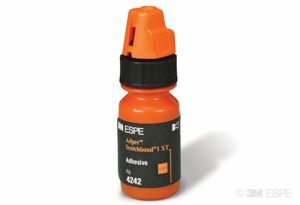
The composition of the drug Adper Sing Bond 2 is distinguished by the absence of monomer and silane. The filler also changes in it. It already consists of particles having a size of up to 5 nm.
Foma of release - a vial in volume of 6 ml or blisters containing one dose. Buy it can be in 2 versions:
- introductory kit containing an adhesive bottle, Scotchbond etching gel with applicators for application, mixing tanks, brush handle and 50 tips for it;
- is separately a vial with an adhesive.
Properties of materials
These materials have adhesion to both enamel and dentine. The connection with the enamel surface is due to dimethacrylate.
It is he who imparts that degree of viscosity that is necessary to penetrate all micro roughness on the surface of the enamel. After the polymerization process, polymer processes are formed, which affect the creation of retentions between the composite and the tooth surface. With the composite material, the adhesive system is connected through chemical bonds.
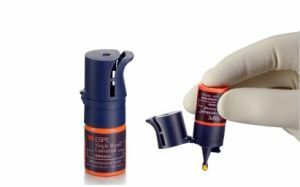 The connection with dentin will be different. As you know, there is a lubricated layer on its surface that appears after the carious cavity has been treated. It interferes with the interaction of the composite with the tooth tissues. The action of all the adhesives is aimed at changing it.
The connection with dentin will be different. As you know, there is a lubricated layer on its surface that appears after the carious cavity has been treated. It interferes with the interaction of the composite with the tooth tissues. The action of all the adhesives is aimed at changing it.
SingleBund Universal does not remove this layer completely, but dissolves in it, transforms and penetrates into the composition under the influence of photopolymerization.
Single Bond 2 works on a different principle. It completely removes the hybrid layer, replacing it with its monomers after polymerization.
Scope
Both substances are used for all types of dental restorations:
- production of seals from composites and compomers for any class of carious cavity;
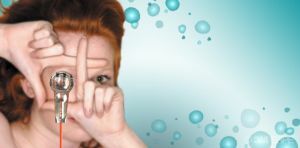
- treatment of carious cavities before the installation of amalgam fillings;
- , apart from sealing, they can be used to restore chipped ceramic and metal structures;
- together with polymer cement, bonding is possible when fixing all kinds of indirect restorations, including veneers;
- use when creating a stump of a tooth from light-curing material;
- coating of sealants after insertion into fissures of milk teeth;
- also, thanks to the ability to seal dentinal tubules, such material is shown with increased sensitivity of the bare tooth roots of the tooth.
How to use?
Method of use for direct restorations with composites:
- Isolation of the working field with a cofferdam.
- Treatment of carious cavity.
- When using the Single Bond 2 system, a pickling gel is used. First it is applied to the enamel, and then to the dentin. After 15-20 seconds the
 is washed off. The best way to eliminate excess moisture is to use a cotton ball. As a result, the dentin surface will look shiny with no moisture.
is washed off. The best way to eliminate excess moisture is to use a cotton ball. As a result, the dentin surface will look shiny with no moisture. - Then the material itself is applied. Carefully open the lid of the vial and drip a small drop of adhesive onto the applicator. Further it is introduced into the cavity by rubbing into the walls for 15 seconds. After a layer of substance is blown with air, to evaporate the solvent. If necessary, additional material can be added by the same method. It is recommended to apply 2-3 layers.
- The polymerization of the material lasts 10 seconds.
- Sealing by the method prescribed by the selected material.
Technique for fixing indirect restorations:
- Treatment of the internal surface of the structure by Silane. Usually this is done by a dental technician in the laboratory. He etches the prosthesis
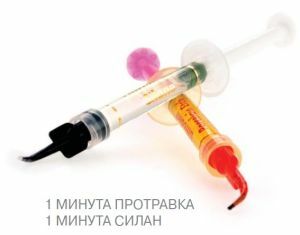 with hydrofluoric acid. If necessary, this manipulation can be repeated in the dental office.
with hydrofluoric acid. If necessary, this manipulation can be repeated in the dental office. - If the restoration is made of ceramics, then it is applied a special primer for this kind of material.
- Preparation of processed teeth with a sandblaster.
- Fitting the design using a special dressing paste.
- Etching with orthophosphoric acid, washing them after 15 seconds. Removal of excess moisture with cotton balls.
- The method of applying the adhesive is the same as for direct restorations. The exception is the rejection of polymerization at this stage.
- Application of material for restoration.
- Cement application.
- Install a veneer or a tab. After positioning, excess cement is removed at the edges. Polymerization begins with the cervical region, gradually moving to the main part of the tooth and cutting edges.
Special instructions
Before using the material, it is necessary to clarify the patient's presence of allergic reactions to the drug components. If intolerance is observed, it is recommended to conduct allergic tests and select another adhesive system prior to treatment.
The doctor should work in protective gloves, a mask and glasses. If the glove is damaged, it is immediately replaced with a new one.
It is important not to allow the disappearance of substances on the mucous membranes of the eyes, mouth and respiratory tract. Otherwise, they are washed with water and immediately consult a doctor.
Price and analogues
The price of Single Bond Universal is 2500-2700 rubles, the cost of Single Bond 2 is 1300-1600 rubles per one bottle.
The analogues of Single Bond are:
- Bond Force;
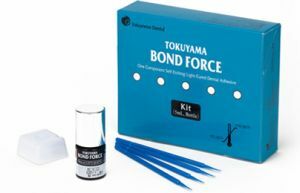
- GC G-Bond;
- GC G-aenial Bond.
Analogs Single Bond 2:
- Prime & Bond NT;
- XP Bond:
- Gluma Bond.
